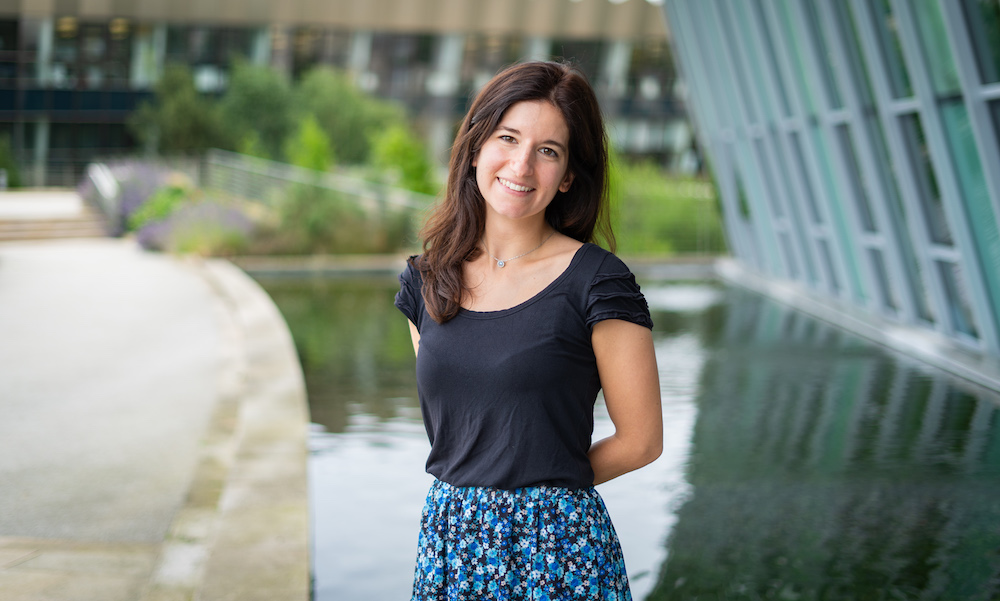
Read the latest Issue
PhD student Valentina Lorenzi is using single-cell sequencing data to create a map of the developing human reproductive system

Human reproductive development represents an area of research that, despite its fundamental importance, has been overlooked in the past due to societal sensitivities. Today, the complexity and importance of this field are becoming increasingly recognised, leading to significant research that could transform our understanding of reproductive health.
Valentina Lorenzi is a PhD student jointly supervised at EMBL-EBI and the Wellcome Sanger Institute. Her work aims to create an in-depth picture of the human reproductive system’s development, documenting and analysing all associated cell types throughout human prenatal life. To achieve this, Lorenzi is harnessing the power of cutting-edge single-cell and spatial genomics technologies, marrying computational expertise with biological insight. We spoke to her to find out more.
My project focuses on the early development of the human reproductive system, which includes understanding how it emerges during prenatal life. It’s a challenging area due to a lack of existing literature and the social stigma around reproduction. My aim is to create a spatially resolved map of all cell types in the reproductive system over the course of development, using single-cell and spatial genomics technologies.
My work is entirely computational and relies on the great work of experimental scientists generating a lot of single-cell and spatial data. I analyse these data and integrate them to gain valuable biological insights. My specific interests are understanding the organ development process, for example, how the Müllerian ducts – simple tubular structures present in the early embryo – transform into the fallopian tubes, uterus, or cervix in later stages of development.
Spatial data is crucial to this project because it allows us to accurately pinpoint where the different types of cells are located and therefore to comprehend the dynamic changes and interactions happening during organ development.
My goal is to create an in silico map of how the reproductive system develops in humans. This map will serve as a foundation to better understand reproductive conditions that have their origins in prenatal development and to establish in vitro models that can be used for testing drugs or other compounds related to reproductive health.
For example, one important area to assess is the effect of endocrine-disrupting chemicals (EDCs) on reproductive development. EDCs are chemicals commonly found in plastics or food items that can interfere with the normal functioning of hormones. Given that the development of the reproductive system is tightly regulated by hormones, even small quantities of EDCs present in everyday products can have a profound impact on reproductive health.
Collaboration is crucial, especially for big projects that require diverse expertise. I’m not a reproductive biologist by training, but I have proficiency in bioinformatics and data analysis. The Marioni Group formerly at EMBL-EBI and the Vento-Tormo Group at the Wellcome Sanger Institute combine excellence in computational method development, genomics and biological interpretation, creating a unique research environment for this project to flourish. Everyone in our teams contribute significantly, and collaborating with experts in different areas is invaluable for our work.
The IBSA Fellowship supports individuals working on underfunded disease areas, such as fertility and urology. I saw an opportunity to connect this with my work on reproductive development. The fellowship is unique in that it focuses on supporting the training of the awardee, rather than providing funds for research and consumables. It allows me to attend more conferences and courses, increasing my training and networking opportunities.
The scale of the projects going on across EMBL was initially overwhelming. However, the supportive environment here encourages constant learning, which has helped me adapt. There haven’t been specific obstacles, except for this constant need to learn and grow, which is intense but rewarding.
The research environment at EMBL is conducive to interaction and discussion. The opportunities to learn are immense with resources and events to foster networking and career growth.
I have a deep interest in women’s health, which I consider a largely overlooked area, and it’s tangentially related to my research project. Over the past couple of years, I’ve been involved with the Cambridge University FemTech Society. I’ve held positions as Vice President and now as President. We focus on the intersection of women’s health and technology, aiming to expose students to advancements in women’s health research and how technology can help solve persistent challenges in the field.
I also love dancing, particularly Bachata, a Latin partner dance. The community here in Cambridge is large and welcoming. It’s an activity that allows me to disconnect from work and enjoy the music and movement.
Looking for past print editions of EMBLetc.? Browse our archive, going back 20 years.
EMBLetc. archive